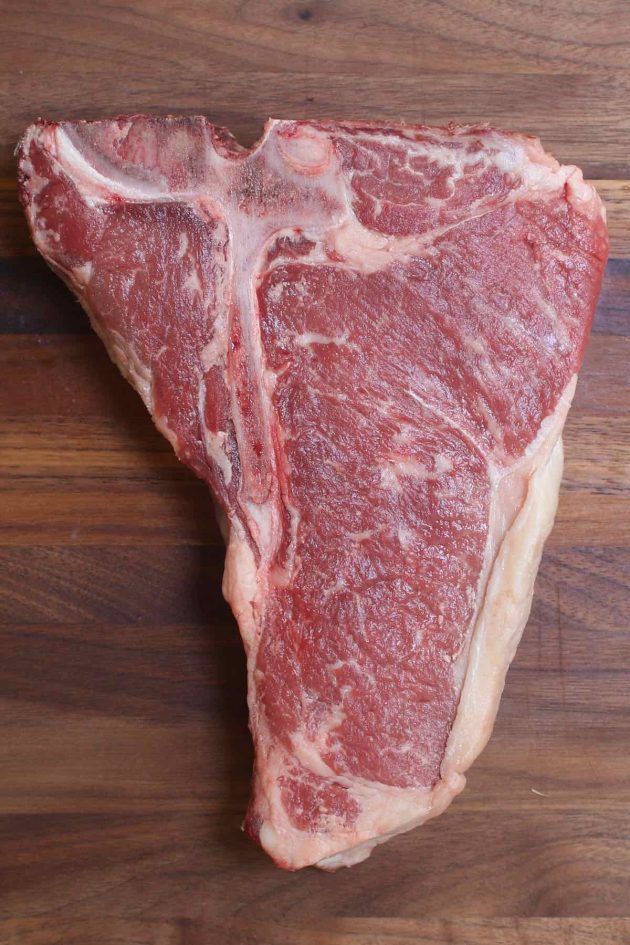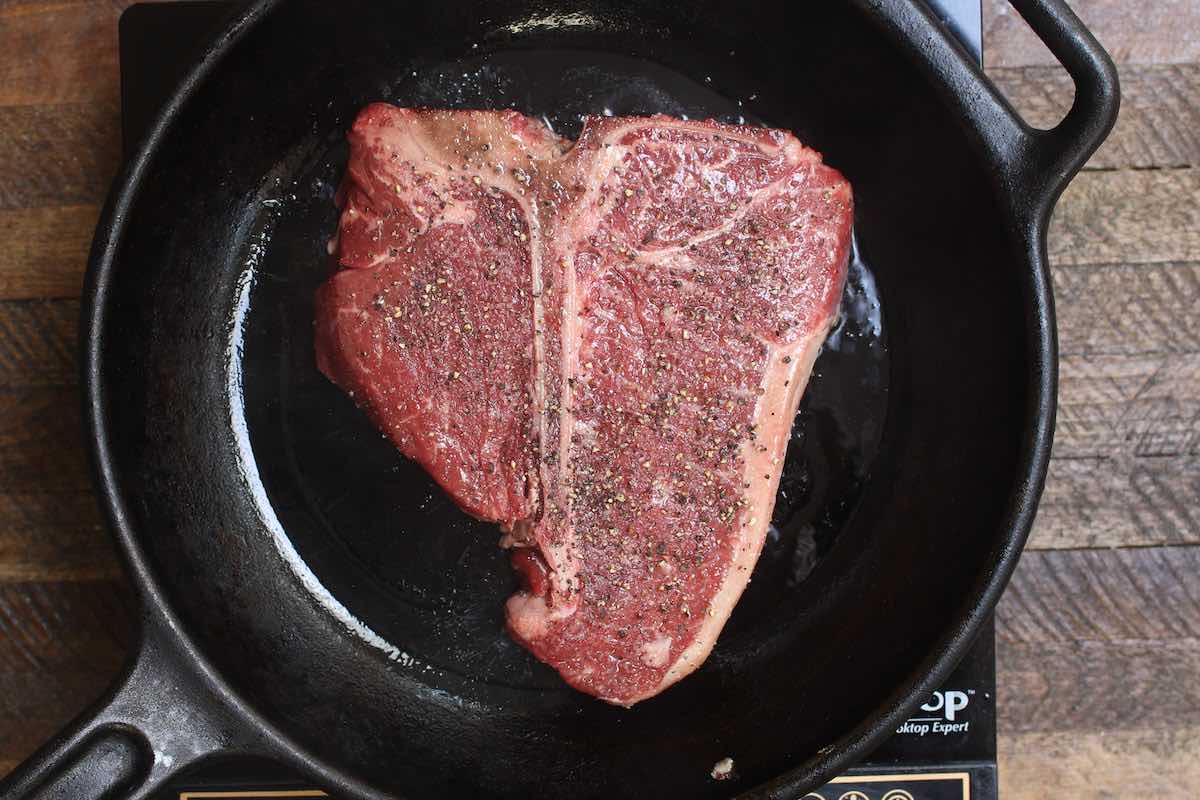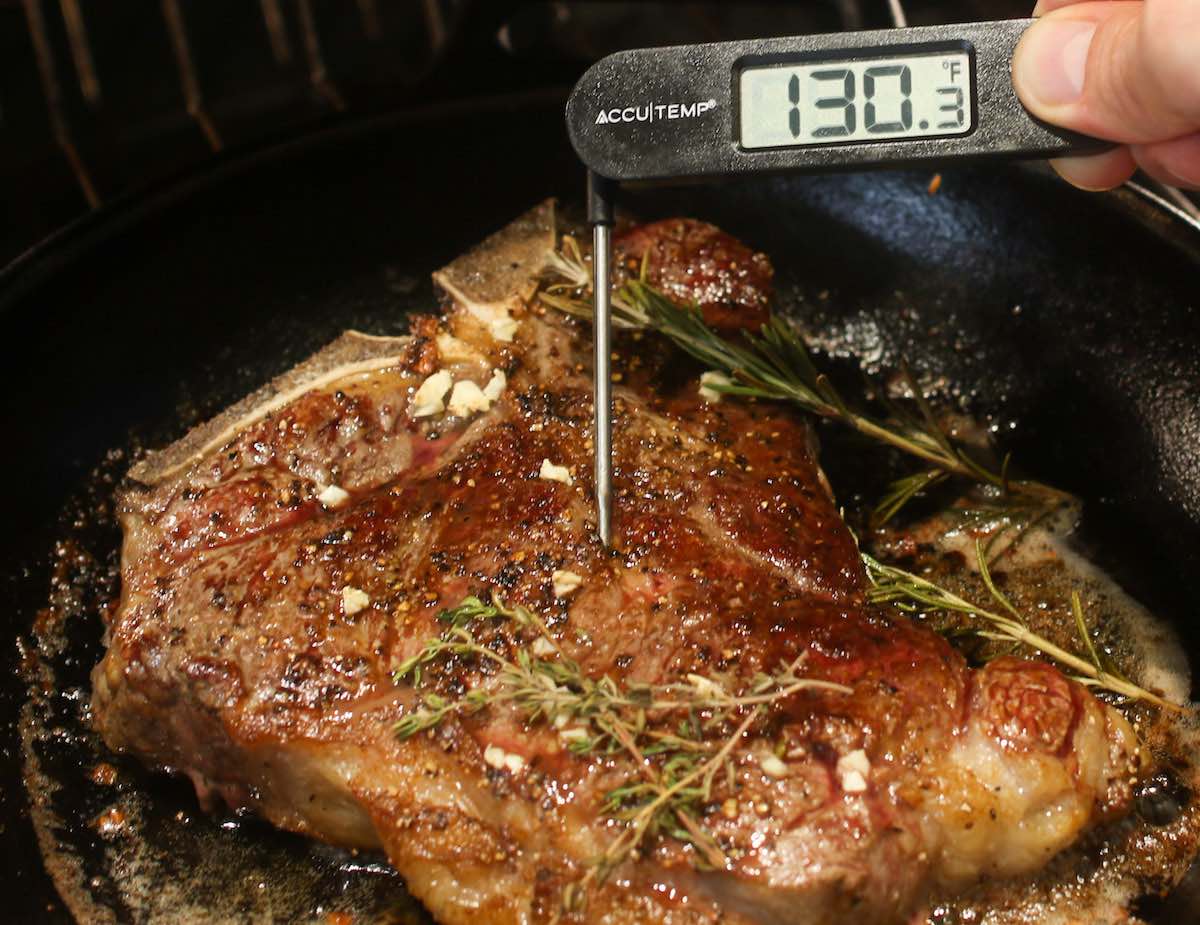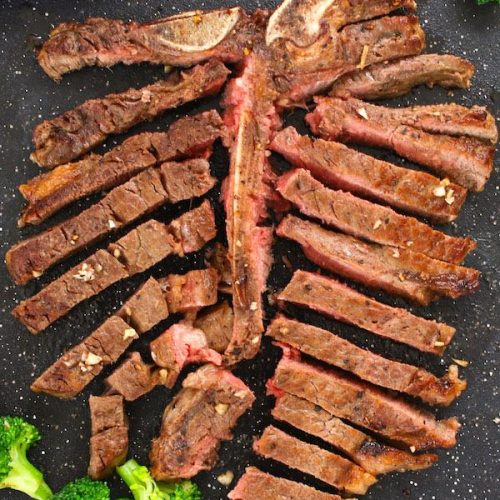Porterhouse Steak
This post may contain affiliate links. Please read the disclosure policy.
This Porterhouse Steak rivals that of your favorite steakhouse restaurant! For this expensive cut, you’ll want it to come out tender, juicy and flavorful. Here you’ll find everything you need to make a perfect porterhouse every time!

Ever wonder why people call a porterhouse the king of steaks? The fact is, this is one of the best steaks money can buy and it’s fabulously large. So big, in fact, that it can serve two people!
You can make it for a celebration like a date night, birthday or a smaller holiday dinner. Perfect for the steak lover in your life! Keep reading to find out everything you need to know about this cut…
What Is a Porterhouse Steak?
The porterhouse is a large beef steak coming from the loin primal. It features two distinct cuts from the short loin sub-primal with a T-shaped bone in the middle. On one side is a tenderloin (filet mignon) and on the other is a top loin (New York strip).
These two muscles, the psoas major and the longissimus dorsi, do little work and are well-marbled with little connective tissue. As a result, they’re ranked the top-3 most tender beef cuts according to Texas A&M Meat Science.
Porterhouse steaks weigh approximately 2 pounds each, making them large enough for two people. A 3-ounce serving contains 210 calories according to the USDA.
The steak’s origins are contested. The New York Times reports it was invented in 1814 by restauranteur Martin Morrison at a porter house or steakhouse pub on Pearl Street in Manhattan. However, Bostonians claim it was created by innkeeper Zachariah Porter in Cambridge, Massachusetts.


Porterhouse vs T-bone
These steaks are very similar with both containing the tenderloin and top loin. The porterhouse comes from the short end of the shortloin, while the T-bone comes from the long end. As a result, the T-bone has a smaller tenderloin and a larger strip. The USDA classifies them as follows:
- Porterhouse: the tenderloin must be 1 ¼ inches or more in the widest section
- T-bone: the tenderloin must be between ½ inch and 1 ¼ inches wide
Which one is better? I favor the porterhouse, so I don’t finish the tenderloin in a few bites like on a T-bone. Try them both to decide for yourself!
Which one is more expensive? The porterhouse is slightly more expensive pound-for-pound than a T-bone, which makes sense since a tenderloin has a higher price than a strip. Also, T-bones tend to go on sale with some frequency, while porterhouses do not.
Porterhouse vs Ribeye
Deciding between a porterhouse and ribeye steak? They both contain the prized longissimus dorsi muscle, making them both fabulously juicy and tender. According to Texas A&M Meat Science, the ribeye ranks #5 most tender instead of top-3. Are we splitting hairs here?


The ribeye has several advantages in the battle for steak supremacy given it’s:
- a single muscle with a consistent flavor and texture rather than two distinct cuts.
- a smaller steak suitable for an individual serving.
- more widely available in supermarkets and slightly less expensive.
- available boneless or bone-in.
Bottom line: you can’t go wrong with either one!
The Best Way to Cook a Porterhouse Steak
Porterhouse is perfect for quick, high-temperature cooking methods thanks to its fat marbling. The three main cooking methods are grilling, broiling in the oven or pan-frying with sous vide and smoking being other possibilities.
The grill and oven have the advantage of easily accommodating the sheer size of this steak, allowing you to cook multiple steaks at once for a party. For pan-frying, you’ll need one large skillet per steak! That means you’ll need two large skillets and two burners for two steaks, making it rather cumbersome. The best rain-or-shine option would have to be the oven!


How to Cook Porterhouse Steak
Before cooking this steak, there are a few preparations required. First, you want to remove it from the fridge an hour ahead to take the chill off for more even cooking and juicier meat. Second, before cooking pat dry with paper towels to remove excess moisture that will interfere with searing. Third, rub all sides with a high-smoke point oil like canola. Finally, rub generously with salt and pepper plus any other seasonings. Your steak is now ready to cook!
Grilled Porterhouse: Preheat the grill to 450°F (230°C). Grill for 5 to 7 minutes per side with the lid closed until your desired doneness. Rotate the steaks 45 degrees halfway through to get crosshatch grill marks. Remove and rest the steaks for 5 minutes before serving.
Oven: Preheat the grill to 425°F (218°C) with the rack in the upper middle position. Place the steaks on a drip broiler pan. Roast for 6 to 8 minutes per side until they reach your desired doneness. Remove and let the steak rest for 5 minutes before serving.


Pan Frying: Preheat a large cast iron skillet for 5 minutes over medium-high heat. Turn the exhaust fan on (required). Using kitchen tongs, place the steak in the pan to sear for about 5 minutes. Flip and cook 3 to 6 minutes more depending on your desired doneness. Remove to a serving plate to rest for 5 minutes before serving.
You can also do the “stove to oven” method by starting on the stovetop for 3 minutes and transferring to a preheated oven to finish cooking. The results are fabulous, but it’s a bit more complicated.
The full recipe with measurements is at the bottom of this post.
When Is It Done?
Cooking times vary widely based on your kitchen equipment. Also, a cold steak straight out of the refrigerator will also cook more slowly than a room temperature steak. The solution? Check the internal temperature of the meat using an instant-read thermometer inserted into the middle of the steak about an inch away from the bone:

- Rare steak with a cool red center is 125°F (52°C)
- Medium-rare with a warm red center is 130°F (54°C) → recommended
- Medium with a warm pink center is 140°F (60°C)
- Medium-well with a slightly pink center is 145°F (62°C)
- Well done with little or no pink is 155°F (68°C) or higher → please don’t do this
Note that the internal temp will rise another 5°F or more as the steak rests once removed from the heat. The USDA stipulates cooking beef to 145°F followed by a 3 minute rest to ensure all harmful bacteria have been eliminated.
Serving Ideas
While you can eat a porterhouse whole, it will fill up an entire plate! For this reason, most people prefer to cut it into strips off the bone for easy serving and an attractive presentation. Simply run a sharp knife along the bone to separate the meat and then cut it into strips.

There are many delicious side dishes to serve with this fancy steak. Here is a small sampling of ideas:
- Potatoes: French fries (steak frites), boiled potatoes, scalloped potatoes, baked potato, smothered potatoes etc.
- Vegetables & Salads: Mushrooms, green beans, asparagus, broccoli, Brussels sprouts, carrots, parsnips, blooming onion, cauliflower, wedge salad, green salad
- Condiments: Creamed horseradish, garlic butter, demiglace sauce, chimichurri, steak sauce
You can also consider serving garlic bread or dinner rolls at the table.
Storage and Reheating: Leftover steak will keep well in an airtight container in the fridge for up to 4 days according to the USDA. You can also freeze it for up to 3 months when tightly sealed. Reheat the steak in a skillet or 350°F (177°C) oven for 5 to 10 minutes or until hot.
You May Also Like:
- Tomahawk Steak
- Cowboy Steak
- Kansas City Strip Steak
- Top Sirloin Steak
- New York Strip Steak
- Filet Mignon

Pan-seared Porterhouse Steak
Ingredients
- 1 large porterhouse steak, about 2 pounds, or 1 1/2 inches thick
- 1 tablespoon canola oil, divided, *(see note)
- 1 teaspoon coarse salt, or to taste
- 1 teaspoon black pepper, freshly ground, or to taste
- 2 cloves garlic, finely chopped (2 teaspoons)
- 1 tablespoon unsalted butter, **
- sprigs fresh herbs (rosemary, thyme etc), optional garnish
Instructions
- Optional: Remove the porterhouse steak from refrigerator one hour ahead of time. This will take the chill off to promote even cooking for the juiciest steak.
- Preheat the oven to 425°F (218°C), placing the oven rack in the upper middle position.
- Place the steak on a work surface. Pat dry both sides with paper towels to remove excess moisture that could interfere with searing.
- Rub the steak on all sides with 1 tablespoon of oil. Then rub the salt and pepper on all sides. (You can adjust the salt to taste, but will need a good half teaspoon to get tender steak.)
- Place a large ovenproof skillet*** over high heat. Allow it to heat for 4 to 5 minutes until very hot and ensure your kitchen exhaust fan is turned on. (Another option is to place the skillet in the preheated oven for 10 minutes.)
- Using kitchen tongs, carefully place the porterhouse in the pan. Let it sear undisturbed for 2 minutes. Then flip and sear the other side for 2 minutes. (Use oven mitts to avoid burns, as the pan handle will be hot.)
- Add the minced garlic, butter and fresh herbs to the pan. Immediately transfer the skillet to the preheated oven and close the door.
- Bake until the steak reaches your desired doneness. Start checking the internal temperature of the meat after 5 minutes by inserting an instant-read thermometer an inch away from the bone. Rare is 125°F / 52°C, Medium-rare is 130°F / 54°C, Medium is 140°F / 60°C, Medium-well is 145°F / 62°C, and Well-done is 155°F / 68°C or more.
- Remove the steak to a cutting board. Cover with aluminum foil to keep warm. Let it rest undisturbed for 5 to 10 minutes to let the juices redistribute. (Avoid cutting into the meat as juices will escape and make the steak tougher.)
- To serve, cut the meat away from the bone. Then slice across the grain into strips.
Notes
- * or another high smoke point oil such as sunflower oil, avocado oil or refined olive oil. Do not use extra virgin olive oil, which will smoke.
- **Unsalted butter is preferred, since it will not burn as easily as salted butter.
- ***You will need a large 12-inch ovenproof skillet (or preferably 14-inch), ideally cast iron.
- Note that cooking time will vary significantly by steak thickness and temperature. A thicker steak will take more time, as will a chilled steak.
Please read our nutrition disclaimer.
© TIPBUZZ. Images and text on this website are copyright protected. Please do not post or republish without permission. If you want to republish this recipe, please link back to this post. This post may contain affiliate links. Read the disclosure policy here.








I was very worried I’d ruin it but this worked perfectly! The only thing I did differently was salted the steaks the day before and let them sit on a drying rack until 30 minutes before cook time, then added my other seasoning. Thank you!
Hi Alex, Thanks for your feedback and glad you enjoyed!
PerfectOooo!! However, I sautéed some onions and mushrooms, with a little bit of fresh minced garlic, S & P and topped it off at the end!! Absolutely the best, easiest steak that I’ve ever had the pleasure of cooking and eating!! 10**********Stars out of 10**********
Hi Tammy, Wow that sounds amazing. Better than the original recipe maybe!? Thanks for your comment.
This recipe was perfect. I felt like I was eating at Morton’s strak house but in my living room. Thank you so much for this recipe it was divine 👍❤️
Hi Michelle, Thanks so much for your feedback and glad you enjoyed! (Probably cheaper than Morton’s!)
Great recipe for indoor cooking.
My husband said best steak he has ever had even in a restaurant Thank You
Hi Val, That’s amazing to hear and I couldn’t agree more! Thanks for your comment
Very good recipe. Mine came out perfectly as to the instructions. Much appreciated where my grill has been iced up and I have been forced to cook indoors.
Hi Richard, Thanks and great to hear that!
200 Celcius fan forced with 3 porterhouses- all reportedly perfect thanks to this guide. Thanks very much 🙂
Hi Mary, Thanks for your feedback and great to hear they came out perfectly. Three porterhouses are enough to feed a crowd!
I bought this expensive steak for New Year’s Eve. Was scared I would mess it up. This gave me confidence of what to do and it turned out PERFECT!
Hi Rhonda, I know, right? You want to get it just right with the price tag on a porterhouse. Glad it turned out perfectly – the highest compliment. Congrats!
This is not a Porterhouse steak cut. It is a T-bone steak cut. Porterhouse cut does not have a bone nor does it have the eye fillet cut attached.
Hi Stewart, Thanks for your comment! Porterhouse is definitely a bone-in cut. As for T-bone, the USDA regulation states the tenderloin section has to be 1 1/4-inch wide or less to qualify. Any bigger and it’s automatically a porterhouse: https://www.ams.usda.gov/sites/default/files/media/IMPS_100_Fresh_Beef%5B1%5D.pdf
I hope that helps and enjoy!
This steak is PERFECT! Exactly what I was looking for, tastes like it’s from a fancy steakhouse! We loved it, thank you!
Hi Michelle, Thanks for your comment and so true about the steakhouse!